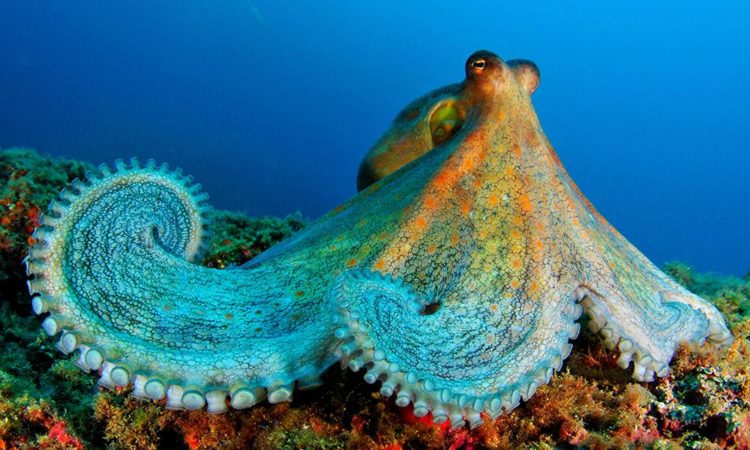WA’s marine life has everything. Colourful coral reef fishes, huge whale sharks and manta rays, turtles, many species of shark, plus large bodied goliaths’ whales and orcas. This amazing diversity of marine life is supported because of the sheer distance our coastline stretches, from the warm north to the cool south.
Our over 10,000km of coastline in WA spans beaches, bays and estuaries and adjacent open ocean. The waters in the north are warm, and house tropical coral reef and mangrove ecosystems. They are also the perfect stopping place for humpback mothers to have their calves before migrating back down to the cooler waters of the south and onto Antarctica. The waters in the south of WA are cool in comparison and provide habitats and food for diverse temperate ecosystems. Connecting it all up is the Leeuwin Current! This current is very important for WA’s marine plant and animal life, as it acts like a conveyor belt between the warm northern and cool southern waters. Strongest during winter, the current travels down the west coast, wrapping around the south west cape and heading east towards South Australia and Tasmania.
Colourful Coral Reefs of Ningaloo, Rowley Shoals, Cocos Keeling Islands
WA has epic coral reefs! Coral reefs thrive in warm waters which are low in nutrients, such as those found at Rowley Shoals, Ningaloo Reef and Cocos Keeling Islands. These coral ecosystems are complex, colourful and full of life! Reef building corals are for the most part fueled by sunlight (makes sense why they are in the north!). The thousands of animals making up each coral colony are known as polyps. Corals are Cnidarians have stinging cells similar to their cousins the jellyfish (each tiny polyp actually looks like upside down jellyfish with tiny tentacles facing upwards). Although polyps can catch some food with their stinging tentacles, most of the food for corals is generated through the power of the sun. Here tiny algae in the polyps are called zooxanthellae and through photosynthesis produce energy. This is so important, as it allows the corals to grow skeletons which are round, branching, in whorls and so many more shapes. These coral reef ecosystems are so exciting to visit, with whale sharks, turtles, manta rays, and of course many many fish!
Tropical Fishes
Corals represent food for some species, such as beautiful yellow butterflyfish and the giant green humphead parrotfish who both like to eat corals (in very different ways!). As we’ve said, healthy coral reefs in WA are complex and have lots of crevices and things to hide under – therefore they also provide lots of different homes. Our own Ningaloo Reef is home to over 500 species of fish coming from many fish families.
Some of our favourites are the the sassy damselfish (Pomacentridae) who often live close to corals or up in the water column eat plankton floating by or some nip algal turf growing on coral rubble below; gobies (Gobidae) how are known to share holes with shrimp in a mutual relationship; blennies (Blennidae) long little fish with googly eyes which can zip around the place and are a bit territorial; surgeonfish and unifornfish (Acanthuridae), herbivores with sharp spines near their tails and can be in huge schools, and many species of colorful parrotfish (Scaridae) who nip away at algal turf and keep our reefs in top shape. With all of this tasty prey around, it makes sense that big bighty predators such as groupers (Epinephelus) and snappers (Lethrinus and Lutjanidae) spend a lot of time in and around coral reefs. And of course there are the reef sharks. There are certain places along the Rowley Shoals and Cocos Keeling Islands which have some of the highest abundances of reef sharks in the world!
Sharks
Blue, great white, tiger, wobbegong, oceanic whitetip, white tip reef, black tip reef, grey, bronze whaler, hammerhead, bull, lemon and many more! In WA we have a lot of sharks, it’s one of the things our great state is known for. Some of them are known to be bighty, and others are mighty shy. Reef sharks are typically found in and around coral reefs, and although they can be a little aggressive, for the most part when you’re out for a snorkel they stay at bay. Sharks to the south can be a bit more intimidating though. For instance the great white shark has been known to attack people, and the bull shark and bronze whaler can also be less than friendly. People in WA recommend avoiding the water during dawn or dusk, or if there is a reason for sharks to be around like a whale stranding. Although the idea of sharks can be a bit scary, they are very important in our ecosystems and often play the role of apex predator (well if an orca isn’t around that is).
Whales
We have a special relationship with whales on our WA coastlines. Seeing them from the shore during winter months up and down the coast is a buzz, especially humpbacks whose aerial displays are something to be seen to be believed. The gorgeous and giant southern right whales are a special sight to behold as they bob around in the winter time with their calves. Places such as Augusta and Point Anne in the Fitzgerald National Park are must visit places if you are a lover of whales.
Dolphins
So many dolphins!!! Indo-Pacific bottlenose, humpback, striped, common, snubfin, false killer whale, pilot whales and of course orcas are all found in WA waters. It’s both common and great fun to see these leaping predators in our waters from north to south. Typically feeding on fish, dolphin species are known for their communication and teamwork in filling up their bellies. And of course their aerobatics!
Orca
Of all of the dolphin species, the most exciting to see has to be the ocean’s apex predator – the orca. On rare occasions they can be spotted in the Perth Canyon and up in Exmouth. But the very best way to see Orca out in the wild is to go whale watching in Bremer Bay. Ocas aggregate at the Bremer Canyon over the summer months each year, and some of the things you will see them do will blow your mind. When they decide to hunt, they really are a force to be reckoned with.
The marine life in WA ranges from colourful, graceful, gentle to fierce, rough and trouble. From north to south, things are constantly changing along the west coast. Definitely worth the journey!

